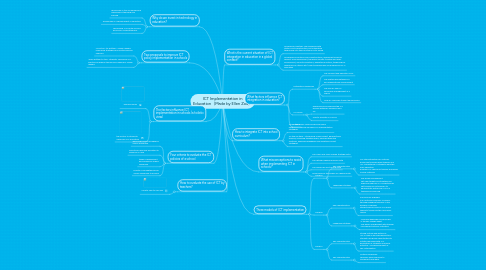
1. Why do we invest in technology in education?
1.1. Technology is tool for addressing challenges in teaching and learning
1.2. Technology is a change agent in education
1.3. Technology is a central force in economic competitiveness
2. How to evaluate the use of ICT by teachers?
2.1. Click to see it in full size
3. Four criteria to evaluate the ICT policies of a school
3.1. learning goals encouraged by school leadership
3.2. priority for resource allocation to enhance ICT use
3.3. types of assessment encouraged by school leadership
3.4. priority of competencies for school leadership to acquire
4. Two proposals to improve ICT policy implementation in schools
4.1. “From top –to-bottom”: School leaders make wise strategies and invite everyone onboard
4.2. “From bottom-to-top”: students' successful ICT practices influence the decision making of school leaders
5. The factors influence ICT implementation in schools (a holistic view)
5.1. Tearles’s model
5.2. the factors to stimulate classroom ICT innovation
6. What factors influence ICT integration in education?
6.1. Distributed Leadership
6.1.1. The concept and definition of DL
6.1.2. The relationship between DL and organizational improvement
6.1.3. The role DL plays in successful management of a school
6.1.4. How DL improves student performance
6.2. ICT Policy
6.2.1. examining and comparing the ICT policies between Singapore and HK
6.2.2. How to evaluate ICT policy
6.3. Others
7. What is the current situation of ICT integration in education in a global context?
7.1. Developed Countries: well equipped with state-of-art infrastructure, but integrating technology into the curriculum is still failing
7.2. Developing Countries: poor infrastructures, insufficient financial support from government, the whole society (political and legal environment, security conditions, educational system, technological awareness of citizens etc.) hasn’t prepared well for embracing ICT in education
8. How to integrate ICT into school curriculum?
8.1. Study successful cases and borrow some experiences before deciding ICT implementation strategies
8.2. Try the six steps: introducing a new project, general/basic training, surveying targeted users, planning effective solutions, analyzing feedbacks and adjusting current strategies
9. What misconceptions to avoid when implementing ICT in schools?
9.1. The vision and clear change strategy myth
9.2. The detailed change process myth
9.3. The resources and training myth
9.4. Technology as the engine for change myth
10. Three models of ICT implementation
10.1. Model A
10.1.1. Key characteristics
10.1.1.1. NO strong traditions or cultures; Enhanced teaching effectiveness and ICT competence of students were the main objective; Emphasis on sharing of teacher-produced course materials
10.1.2. Leadership strategy
10.1.2.1. Top-down management; Set clear targets and timetable for achieving specific ICT competencies Set timeline for all teachers to demonstrate actual use of ICT in teaching and learning
10.2. Model B
10.2.1. Key characteristics
10.2.1.1. Successfully engaged in a continuous process of reform through engaging teachers in the process of change; interest was focused on ICT which supports/ enhances the curriculum reform
10.2.2. Leadership strategy
10.2.2.1. Visionary leadership and principal is the key change agent Top-down arrangement with teacher involvement actively cultivated
10.3. Model C
10.3.1. Key characteristics
10.3.1.1. Strong cultural and historical; ICT is used as an empowering tool; Students are given opportunities to initiate new ideas with ICT; Realization of students’ individual potential – and development of self-actualization
10.3.2. Key characteristics
10.3.2.1. Multiple leadership; Teachers have free hand to implement new ideas
